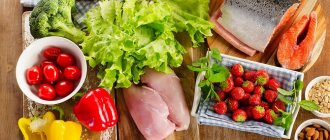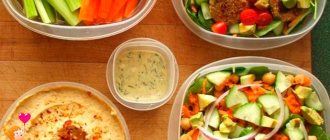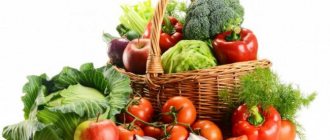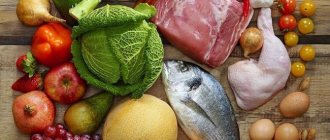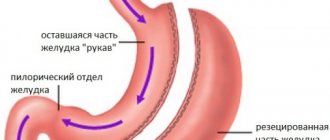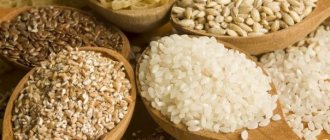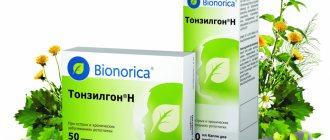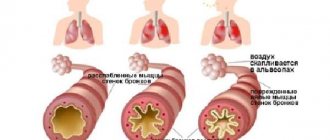Indications for use
Indications for prescribing the diet are diseases of the cardiovascular system, in particular atherosclerosis with damage to the vessels of the heart, brain or other organs, coronary heart disease caused by atherosclerosis and hypertension due to atherosclerosis. Heart disease requires a special attitude in everything - comprehensive attention to your health, quality treatment, lifestyle changes and proper nutrition. Treatment table number 10 is a nutrition system specially designed for heart patients, the purpose of which is to improve blood circulation, help the cardiovascular system, facilitate the functioning of the liver and kidneys, normalize metabolism and establish a gentle mode of operation for the digestive organs.
What's prohibited?
Article on the topic
Heart failure: causes, symptoms and emergency care
People with cardiovascular diseases or a tendency to them should completely avoid :
- products made from butter and puff pastry, cream products and ice cream;
- fatty varieties of meat, poultry and fish, including canned and salted ones, and do not use them for making soups;
- fatty or salty dairy products;
- products that can excite the nervous system, that is, strong tea, coffee, cocoa and chocolate;
- peas and beans;
- some vegetables, such as radishes, radishes, sorrel, spinach and mushrooms;
- marinades, meat, fish and mushroom sauces, pepper, mustard and caviar;
- alcoholic beverages and all carbonated drinks.
Reference
Atherosclerosis is a disease of blood vessels that lose flexibility as a result of harmful factors, become hard due to the deposition of fats on the walls and, as a result, narrow, which reduces blood access to organs. The disease leads to thrombosis and ischemic damage to organs. Atherosclerosis is considered one of the most dangerous diseases that leads to death.
Types of tables No. 10 in the diet
Table No. 10a
Indications:
- diseases of the cardiovascular system with circulatory failure, grade 1-2a.
- myocardial infarction
- cardiosclerosis
- heart defects
This diet is characterized by a protein content at the lower limit of the physiological norm, and fats and carbohydrates should be in moderation. The diet fully provides the body with vitamins C, P, PP, B. The amount of bread is reduced to 150 g per day (that’s 2 slices of bread), a serving of soup is up to 200 ml or is completely excluded, and cheese, millet, barley and pearl barley are also excluded.
Table No. 10b
Indications:
- rheumatism
This diet is high in protein and limited in easily digestible carbohydrates. Allowed and prohibited products completely coincide with the rules of the general table No. 10. In this case, vegetables are boiled or served raw, and dishes should be at normal temperature.
Table No. 10с
Indications:
- atherosclerosis of blood vessels of the heart, brain
- cardiac ischemia
- hypertension against the background of atherosclerosis.
This is a dietary diet with limited salt and fat in the diet. Animal fats are replaced with vegetable fats as much as possible. Be sure to include foods rich in ascorbic acid, B vitamins, potassium and magnesium salts into the diet. Plenty of seafood is also beneficial. Culinary processing of dishes, diet and restrictions are maintained in accordance with basic diet No. 10.
Table No. 10g
Indications:
- essential arterial hypertension
This is a salt-free diet. The diet provides for a high content of ascorbic acid, thiamine, riboflavin, vitamin P, magnesium and potassium salts. The diet includes foods rich in cell membranes, as well as seafood containing organic iodine, such as seaweed.
What is possible
Article on the topic
Assess the risks.
How to get examined for hypertension The list of permitted foods is wide enough to meet the recommended caloric intake of the diet of 2300–2600 calories per day. The list of products allowed by therapeutic diet number 10 includes:
- Eggs in any form, but no more than one per day.
- Whole milk, but only if it does not cause flatulence, cream, lactic acid drinks, low-fat types of sour cream and cottage cheese.
- Cereals, pasta and legumes, which are recommended to be cooked in water and milk.
- Vegetables, for example, can be safely eaten boiled and baked: potatoes, beets, carrots, white cabbage and cauliflower; cucumbers, tomatoes, carrots, lettuce, green onions, dill, and parsley are allowed raw.
- Vegetarian soups with potatoes, vegetables, cereals, as well as milk and fruit soups.
- Sweets in the form of raw berries and fruits, as well as compotes, jelly, jellies, mousses, milk creams, jam, honey, non-chocolate candies, marshmallows, marshmallows.
- Weak tea, surrogate coffee, vegetable and fruit juices, rosehip decoction.
- Unsalted butter and vegetable oils for use in cooking.
Diet for cardiac patients
1.FATS: Recommended: Limit intake of all fats.
Limited intake: Butter and margarine containing polyunsaturated fatty acids in large quantities (in Russia, “Zdorovye” margarine). Oil: sunflower, corn, saffron, soybean, olive, cottonseed.
Not recommended : Oil and fat obtained during frying meat and meat products, lard, coconut oil. Margarines without a high unsaturated fat content label. Melted or vegetable oil of unknown origin. Hydrogenated oils and margarines.
2. MEAT: Recommended: Chicken, turkey, veal, rabbit, game (wild ducks, partridges, hare)
Limited intake: Lean beef, bacon, ham, lean ground beef, liver and kidney.
Not recommended : Meat with visible fat, lamb brisket and ribs, pork (meat from the belly area), bacon with layers of fat, sausages, sausages, salami, pate, scrambled eggs with meat, duck, goose, meat pastes, poultry skin.
3. DAIRY PRODUCTS : Recommended: Skim milk, low-fat cheeses (for example, pressed cottage cheese), skim milk cheese, curdled milk cheese. Low fat kefir. Egg white.
Limited intake: Semi-skimmed milk, medium-fat cheeses (Eden, Camembert). Processed, spreadable cheeses. 1-3 eggs per week. Half-fat cheeses.
Not recommended : Unskimmed milk, condensed and concentrated milk, cream, whipped cream. Fat cheeses: Cheddar, Cheshire, etc. Cream cheeses. Fat kefir.
4. FISH : Recommended: all “white” fish: cod, hoddock, flounder. Fatty fish: herring, mackerel, sardines, tuna, salmon (chum salmon, pink salmon, salmon)
Limited intake: Fish cooked in suitable oil. Shellfish. Marine crustaceans.
Not recommended : Fish roe.
5.FRUITS/VEGETABLES : Recommended: All fresh and frozen vegetables, peas, beans, olives. Dried legumes: peas, beans, lentils. Boiled potatoes (peeled or “in their jacket” (eating the skin whenever possible). Fresh fruits, unsweetened canned fruits, walnuts, chestnuts.
Limited intake: Fried, stewed potatoes cooked in suitable oil. Fruits in syrup. Candied fruits. Almond. Hazelnut.
Not recommended : Fried, stewed potatoes (if they are cooked in unsuitable oil). Potato chips, crispy potatoes.
6. CEREALS : Recommended: wholemeal flour (unsifted), bread made from it, unground (whole) cereals, oatmeal, wheat flour. Oatmeal. Unpolished rice and rice paste. Rusks cooked in the oven. Oat cookies. Yeast-free bread.
Limited intake: White flour, white bread, sweet breakfast cereals, polished (white) rice and rice pasta. An ordinary semi-sweet biscuit. Biscuit made with water.
Not recommended: Cakes. Biscuits with spicy cheese. Confectionery products (cookies, cakes) purchased in a store.
7.BAKING : Recommended: Low-fat puddings: jelly, sherbet, skim milk puddings, low-fat relishes (purees).
Restricted intake: cakes, confectionery, biscuits and condiments prepared with suitable butter or margarine. Homemade snacks with unsaturated fats.
Not recommended : Cakes, puddings, biscuits containing saturated fat. Dumplings, puddings made with fat. Seasonings with cream and butter. All store bought puddings and condiments. Snacks cooked in “boiling” oil (fried side dishes). Milk ice cream.
8. DRINKS : Recommended: Tea, coffee, mineral water, unsweetened drinks, fruit juices without sugar. "Clean" soups. Homemade vegetable soups. Low alcohol beer.
Limited intake: Sugary drinks, low malt drinks. low fat liquid chocolate (rare). Batch soups, meat soups. Alcohol.
Not recommended : Irish coffee (coffee with cream and alcohol), fat-rich malt drinks, chocolate, creamy soups.
9.CANNED CONSTRUCTIONS, SWEETS : Recommended: “Clean” marinades. Sweets without sugar: saccharin tablets or liquid sweets with aspartame.
Limited intake: Sweet marinades and seasonings (from fruits, peppers), which are served with cold meat (curry). Marmalades. Honey. Syrups. Marzipan. Peanut butter. Lemon curd. Hot sweets. Marshmallows, mints, sugar, sorbitol, glucose, fructose.
Not recommended : Chocolate creams, pie fillings made with animal fats. Taffy. Sweets. Cream obtained by whipping butter and sugar. Chocolate.
10. REST: Recommended: herbs, spices, mustard, pepper, vinegar. Low-fat condiments: lemon, yogurt.
Limited intake: Meat and fish spreads, low-calorie cream and mayonnaise. Bottled sauces. French seasonings. Soy sauce.
Not Recommended : Regular salad cream, mayonnaise, cream or dressings containing cream cheese.
EXPLANATIONS FOR DIETARY RECOMMENDATIONS
“Recommended” foods are those that are low in fat and/or high in pectin fiber.
The foods listed in the "limit intake" section contain polyunsaturated fats or small amounts of saturated fat. If your diet contains a small amount of fat, these foods are allowed to a limited extent. For example: “red” meat (limited intake) - i.e. no more than three times a week, medium-fat cheeses and fish spreads - once a week, or homemade cookies, biscuits, confectionery products prepared using suitable (containing polyunsaturated fats) margarine or oils - twice a week, or fried potatoes (baked) cooked in the appropriate oil once every two weeks.
The foods listed in the “not recommended” section contain high amounts of saturated fat and should be avoided as much as possible.
When should you start a diet for cardiovascular diseases?
If you are concerned about any symptoms of the cardiovascular system, I recommend that you make an appointment with a cardiologist and undergo a full examination.
The doctor will ask you in detail about your complaints, what medications you are currently taking, so before seeing a cardiologist, it is better to prepare a blood pressure monitoring diary with measurements in the morning and evening, write down under what physical or emotional stress pain in the heart area appears, whether you feel it under the shoulder blade, in the left hand. If you have already taken medications, note their name and dosage so that the doctor can choose treatment for you.
If there is a lack of vitamins and minerals in your diet, your doctor will select them for you in the form of dosage forms and individually prescribe the dosage
Be healthy!!! And we will always help you find the “Path to Health”
The article was written by physician-therapist L.D. Khazieva.
Why is it important to adhere to therapeutic nutrition for heart disease?
One of the main goals of therapeutic nutrition is to enhance the effect of taking medications prescribed by a doctor. In some cases, with a properly selected diet, it is possible to do without medications altogether or significantly reduce their amount and period of use. For this reason alone, it is worth listening to the advice of an experienced nutritionist and switching to a therapeutic diet immediately after making the appropriate diagnosis.
A nutritionist will help develop a treatment menu and the required level of physical activity at which the load on the heart and blood vessels will be optimal. In addition, a nutrition consultant will tell you which habits you should give up right now.
These include smoking, drinking alcohol, overeating, abuse of simple carbohydrates, leading to obesity and insulin resistance ( diabetes mellitus
is an aggravating factor in cardiovascular diseases).
Another important task of diet therapy is the correction of metabolic disorders that inevitably arise with such diagnoses, relieving the heart from excessive stress, and improving the absorption of food through proper diet.
Thanks to a special diet, it will be possible to normalize weight, lower blood pressure, reduce lipid and blood sugar levels, and reduce the susceptibility to thrombosis. All this will certainly affect your well-being and general health, and will also significantly reduce the risk of developing serious cardiovascular pathologies and complications, disease progression and death.
Allowed foods
Nutrition for angina pectoris includes foods that do not contradict the listed general principles of a healthy diet. These include:
- porridge (wheat, buckwheat, millet, oatmeal, barley);
- dried fruits (dried apricots, raisins, prunes);
- fresh or baked fruits and vegetables;
- vegetable oils;
- fish, seaweed;
- dietary types of meat (game, chicken, turkey);
- dairy products;
- honey.
All of them are rich sources of microelements (phosphorus, calcium, magnesium, iron, potassium, sodium, zinc) and vitamins. In the human body, they normalize metabolism and establish its balance. If angina pectoris is diagnosed, then the diet includes more different leafy vegetables, for example, cabbage, parsley, spinach. You can remove excess cholesterol from the body by daily eating food with coarse fibers, which mechanically cleanse the intestines, slowing down the process of vascular damage. Water balance is achieved by drinking a couple of liters of water per day.
